
Impact Reporting: What, How & Why
16-Feb-2024
Building accountability into the furniture industry
Webinar & Action Guide Series
Furniture defines our behavior and our culture, forms our posture and supports our bodies, literally shaping the way we live our lives. It influences our relationships with others, prompting us to engage or retreat, bringing us together around a table or offering the sanctuary of a bed. It situates us within the built environment, giving purpose and meaning to what would otherwise be just empty space.
Furniture plays such a positive role within our lives, yet it also contributes significantly to our rapidly changing climate. With a resource-intensive and energy-hungry production process, furniture makes up 6–30% of a building’s carbon footprint. Global furniture consumption creates millions of tons of waste each year, leaks toxins into ecosystems and fuels our insatiable appetite for plastics.
How can furniture become part of the landscape of a better future?
Our new Webinar & Action Guide Series, ‘Impact Reporting for Change | Building Accountability Into the Furniture Industry,’ explores voluntary reporting as a key lever for change. Reporting enables companies to reflect upon, analyze and take responsibility for both the negative and positive impacts of their business activities on people and the planet.
Business activities common within the furniture industry - such as waste generation, and use of packaging materials, transportation and energy - have the potential to have a negative impact on the environment or on people within the supply chain or local communities. Timber purchasing, for example, could lead to deforestation and biodiversity loss. Emissions associated with deliveries will contribute to air pollution and climate change. Low wages paid to workers could exacerbate poverty. Plastic packaging materials could end up in marine environments.
Through transparency about the negative effects of furniture production upon our world - and our efforts to address them - we can start to focus on what really needs to change. In sharing our strategies, challenges, failures and successes, we can start to forge a new furniture industry that supports an economy operating within planetary boundaries and working for the benefit of all.
If you are working in the furniture industry and looking to publish your first impact report, or to strengthen your existing reporting - fasten your seat belt - our new series aims to demystify the process, cut through the jargon, break the steps into bite-size pieces, and help build your confidence in reporting:
- In Part 1, below, we look at the purpose behind reporting, the benefits it brings, key content to include and some examples of great reporting to motivate and inspire you.
- Part 2 will explore the nuts and bolts of reporting – how to identify, understand and prioritize impacts so that you can gather the information you need to start making a difference.
- Part 3 will explore impact reporting as a tool for creating change in your company. By assessing the risks and opportunities of specific impacts, we’ll show how companies develop new strategies.
Whether you are a manufacturer, specifier, retailer or designer, this 3-part Action Guide and Webinar Series will guide you through the reporting process, helping you turn dry data into an engaging narrative. You’re invited to become part of a movement for fundamental change across the furniture industry!
Part 1 of 3: The What, How and Why of Impact Reporting

Source: Modus Furniture Impact Report 2022
What is an 'impact report'?
Furniture does not exist in a vacuum. While it may be exceptionally functional or genuinely beautiful, furniture also carries a legacy of consequences or ‘impacts’ that arise as a result of the activities associated with its production - raw material extraction, manufacturing processes, shipping, packaging and selling.
For every plank of wood, a tree has been felled. For every sheet of steel, fossil fuels have been burned to mine the iron ore or recycle the metal. For every meter of fabric, pesticides have probably been sprayed onto cotton fields and workers’ rights may have been undermined during harvesting or production. For every mattress, a cubic yard of plastic foam sits in landfill. These are the kinds of negative consequences, or ‘impacts’, associated with the furniture industry on which reporting focuses.
An impact, or sustainability, report is a publicly available document that tells the story of a company’s efforts to reduce its negative impacts on the environment as well as the steps it is taking to make a positive difference to the lives of others. Reporting should be unbiased, verifiable and transparent – becoming a vehicle through which a company holds itself accountable for its actions and identifies a road map for improvement.
While its roots are in the world of finance, impact reporting encompasses a broader scope than ‘ESG,’ through which institutions report against environmental, social and governance criteria. The ESG model was designed to allay investors’ fears by evaluating and disclosing risks. While the three ‘E’, ‘S’ and ‘G’ pillars still underpin impact reporting, it no longer looks just at the potential risks for shareholders of poor ESG performance. Rather, impact reporting takes a much wider view of all the ways in which a business can adopt sustainable practices to advance positive change on the world.
Why report?
Unlike the oil, gas and agriculture industries, the furniture industry is not considered a high impact sector so in the U.S. reporting is yet to become mandatory. In the United Kingdom and European Union, reporting is mandatory only for companies of a certain size; Why then go to the trouble of writing a report?
The answer lies in the potential for impact reporting to spark transformation. Homing in on and publicly disclosing the impacts associated with furniture - such as resource and water use, carbon emissions, waste creation, or toxic materials - can really sharpen focus and become a catalyst for change.
Publishing an impact report helps a company reap a host of benefits -
TAKE RESPONSIBILITY
By publicly communicating its impacts – both positive outcomes and areas that remain challenging – your company is taking significant steps towards becoming fully responsible for its actions and choices. A really great impact report tells a story of accountability and action, and shows a company’s transformation over time.

Avocado is a California-based mattress and bedroom furniture company. In its 2022 Impact Report, Avocado notes a goal of diverting 80% of its waste from landfill. In this graphic, the company shows its progress from 69% diversion in 2021 to a 78% waste diversion rate in 2022.
STAY ON TRACK
Reporting helps create a baseline against which you can assess performance, set actionable targets and measure your progress toward those targets. It also gives those at the top a clear picture of what needs to be done, helping to inform decision making. Making public commitments makes everyone in your organization more accountable, while a commitment to reporting every year helps keep data gathering and evaluation timely.

In its 2022 Impact Report, Norwegian brand Vestre captures its progress toward targets in six areas. The bar chart at top right, for example, shows an increase in the percentage of FSC certified wood from 10% to 99% over four years. Meanwhile, in the graph at center right, the company explains openly why its share of post-consumer scrap steel has not improved, remaining at 2.6%, or 7.4% below Vestre's 2030 goal of 10%.
MOTIVATE & INSPIRE
A well-rounded report shows employees you are serious about sustainability and opens a dialogue that can lead to employee-led initiatives. Sharing your impact report can also inspire other businesses to ramp up their sustainability efforts so they don’t get left behind. This holds the potential to help shift everyone in the furniture industry in the right direction.
ATTRACT & RETAIN THE BEST TALENT
“There’s a good reason the world’s largest corporations compete for the highest sustainability ranking,” notes Corporate Knights in its 2023 ranking of the Global 100 Most Sustainable Corporations. “The transition is gathering momentum - and businesses that take sustainability seriously are flourishing financially.” Where sustainability was once considered a ‘nice to have,’ it has now shifted to a ‘must have.’ Those at the leading edge have seen transparency in formats such as impact reporting help retain and attract the best talent. One recent study by Deloitte, for example, showed jobseekers, especially Gen Z and Millenials – 85% and 79%, respectively - consider a company’s purpose when choosing where to work.
BUILD CUSTOMER TRUST & LOYALTY
Increasingly, customers need to feel comfortable that a brand’s values align with their own. Transparency about your sustainability journey allows existing and potential customers to see your company’s intentions and progress, improves brand reputation and customer engagement and elevates your company above the competition. The world of furniture is fiercely competitive and awash with green claims. Transparency can help customers see that you have not been silenced into “greenhushing” - diluting or hiding sustainability claims and credentials for fear of scrutiny and being perceived as greenwashing. Impact reporting allows for confident disclosure of progress on your journey.
FUTURE PROOF YOUR BUSINESS
Monitoring your company’s data will help ensure you are prepared for what’s to come. Early adoption of reporting as a core practice helps you not only remain competitive but well-positioned when reporting becomes mandatory.
Currently, reporting is mandatory for only a few of the biggest global players in the furniture industry, yet voluntary reporting is becoming more common, with huge growth in sign-ups to reporting frameworks and standards. These include the Global Reporting Initiative (GRI), United Nations Global Compact (UNGC) and Sustainability Accountability Standards Board (SASB). With the push towards net zero – eliminating all possible carbon emissions and compensating only for those that cannot be reduced – the total number of companies setting Science Based Targets (SBTs) increased 87% in just one year. At the same time, furniture-related companies now account for 114 of the global total of 7,500 Certified B Corporations.
Getting Started

Source: Modus Furniture Impact Report 2022
Writing your first impact report can be mind boggling! Here are some top tips -
PUT YOUR HEADS TOGETHER
Start with a brainstorming session with colleagues from multiple departments. The more you involve, the wider a picture you can form of the potential negative effects of your current business activities. Delineate the journey of your company’s furniture from its very beginnings -- such as the harvesting of bio-materials and extraction of metals or crude oil, for plastic -- through production, packaging and on to final delivery to a customer or end client.
Brainstorm questions such as:
- What damage could have occurred to the environment or to the people with a hand in its making?
- Were harmful substances used?
- Were artisans fairly paid? What about your broader workforce?
- Was virgin forest cut to provide timber? Has it traveled a long way?
- What happens at the end of the furniture’s usefulness to its first owner?
- What are the implications of the wider aspects of the business - such as electricity, vehicle & water usage?
- How does your business affect local communities, from where materials are extracted to where your furniture is produced, sold or discarded?
These types of questions will likely require you to dig a bit deeper into the back story of your furniture, taking a close look at the way your company operates.
KEEP IT SIMPLE
With a better picture of the range of your company’s impacts and potential impacts, start to think about what relevant data you already have or what data you can readily get your hands on. If you want to report on your packaging, for instance, ask the shipping department for data on the volume and types of packaging materials used by the company each year. This data in hand, you can start to set targets to reduce the overall packaging - or, say, plastic packaging - purchased each year.
Concentrate on your key areas of impact - of all the negative outcomes associated with your business activities, which are the most damaging? Try not to get distracted by everything everyone else is reporting on - keep it relevant to your business. Here are two great examples from furniture companies that keep their reporting very simple -


Take a look at this pair of Table of Content pages. Benchmark (top), a British brand, focuses on its strengths, such as healthy materials, product certifications and the carbon footprint of its products. Note that Benchmark does not yet report on operational carbon emissions but instead focus on areas that reflect its artisanal business model. The topics in this Contents page illustrate a simple approach that would make a good starting point for impact reporting for many small businesses. Vestre (bottom) follows a similarly simple style, helping to keep its impact report accessible and manageable even as the company addresses more complex issues such as decarbonization. Vestre includes helpful features such as a glossary of terms and mathematical equations for calculating various impacts.
START SMALL
Don’t try to do too much in your first year. Your first report does not have to offer a full account of all your carbon emissions, or a breakdown of your gender pay gap. Rather, choose where to start, then begin working to improve data, each year expanding what you are measuring.
In a furniture-making firm, for example, a good starting point may be to report on annual energy use or the percentage of sustainable timber purchasing. It doesn’t have to be perfect; it’s better to get started and make a few mistakes than to keep putting it off. It’s contagious - the more furniture companies that report, the more companies that will report, and the greater the pressure to reduce impacts will become across the whole sector.

Floyd, a Detroit-based manufacturer, created a clear, beautifully presented, short and sweet first-time 2021 Impact Report. Note the use of very few metrics, just those related to data readily available to the company. Floyd pledged that “future impact reports will include more data points that will help to illustrate the work we’re doing.” This page, for example, shows employee demographics, information often available from a company’s human resources department.
GET BUY-IN FROM THE TOP
Your company’s CEO and leadership team will have to support and sign off on the disclosures in your impact report, so get them on board right from the start. An impact report is always created retrospectively, covering a year’s worth of achievements, challenges and failures. It’s no mean feat gathering all that information, and you will almost certainly need support from those at the top to make this happen.
As you work with different departments to gather data, it helps to convey why this data matters – and probe how it might be easier to get this data next time.

A meaningful message – see page 4 – from the CEO of Vestre, based in Norway. Too often CEO messages are a bit ‘blah blah blah.’ Here, Vestre’s CEO openly notes that the company changed its mind regarding carbon offsets and has taken a new approach to decarbonization.
LOOKS MATTER
Design your impact report to be as engaging, attractive and accessible as possible. Look at lots of other reports, not just from the world of furniture. Cast a wide net for inspiration about what, and how, information is presented – pie or bar charts, for example, or graphs and tables as well as illustrations, photography and graphics. Aim to create a report that is a feast for the eyes as well as the soul!
Some reports stick to a very clean and almost scientific aesthetic, helping suggest robust data and giving credence to the report. Others favor a much more arty approach, maxing out on color. Use company colors, fonts and graphic style so the report reflects your brand and feels familiar to your customers.
It always helps to have the gift of a visual eye. If that’s not you, call on the creatives in your company. Enlist the graphics or marketing team, or consider commissioning a design agency to translate your report into a piece of art.


Both Williams-Sonoma (top) and Vestre (bottom) offer great examples of eye-catching reports – but in very different styles. Williams-Sonoma favors a quantitative, bar-chart style that lends its report an authoritative tone. Vestre takes a much more stylized, illustrative approach, which emphasizes making information interesting, appealing and accessible.
CHECK OUT OTHERS' BEST PRACTICES
Seeing the hard work of others often motivates us, awakening our ambition – no bad thing if it leads to positive action. Look for examples of best practices that you could adopt into company strategy as well as into your report.
Explore the different formats, or frameworks, that companies adopt when reporting. Some – such as Floyd, Benchmark and Vestre – create genuinely simple reports that sing to their own tune. By contrast, impact reports by large companies tend to be structured around mandatory reporting paradigms, which aligns reporting with standards such as the GRI (see, for example, Brunner), ISO 26000 (see Humanscale), or the UN Sustainable Development Goals (IKEA, for instance). What might work best for your organization?
STORYTELLING - THE HUMAN TOUCH
Don’t forget to include engaging and accessible stories about people, as a complement to all the dry information you need to cover. Human stories are often where readers will feel most connected to your narrative. Alongside data on your total annual waste, for example, feature a story about how you support individuals and initiatives within your community.


THINK STRUCTURE AND FLOW


What to include
FRONT COVER

VISION

In its 2021 Impact Report, Floyd adopted a brief, very simple mission statement that appears repeatedly across all of its outward facing communications. This helps situate the company's impact report, allowing it to become familiar to customers.
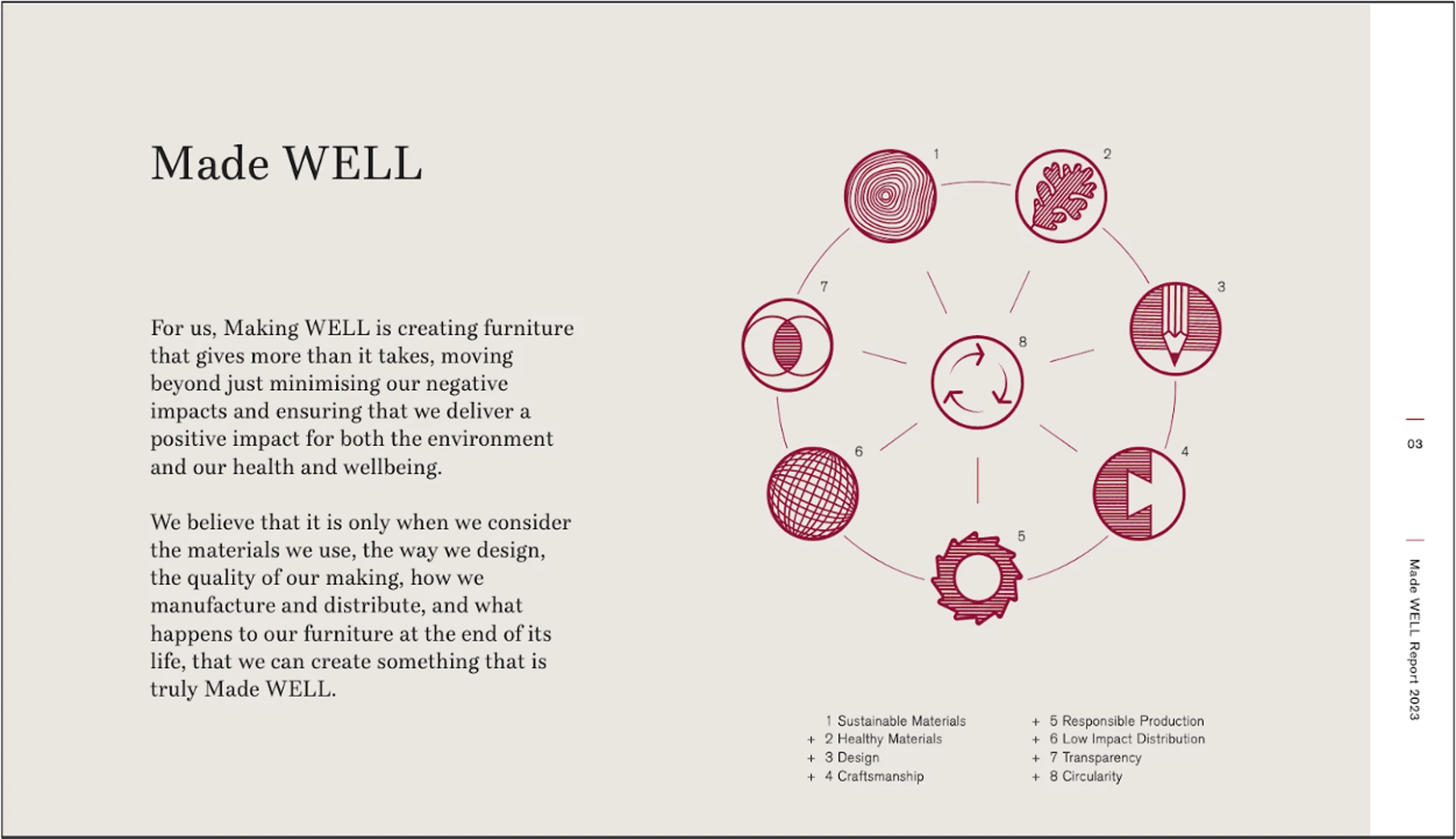

HIGHLIGHTS
This page details recognition, key activities and/or a summary of progress. What has made the company proud this year? This is the ‘sell-y’ bit. Show off any awards, achievements, accreditations and certifications that your company received in the reporting year. This is the bit your CEO will like best so don’t skip it!

Williams-Sonoma features an engaging quote on its Highlights page. The company’s Impact Report 2022 showcases all awards received during the year, including a top score from the Sustainable Furnishings Council for wood furniture, recognition from Forbes as a best employer for women and diverse groups, and a position in Barron’s ‘100 Most Sustainable US Companies’.
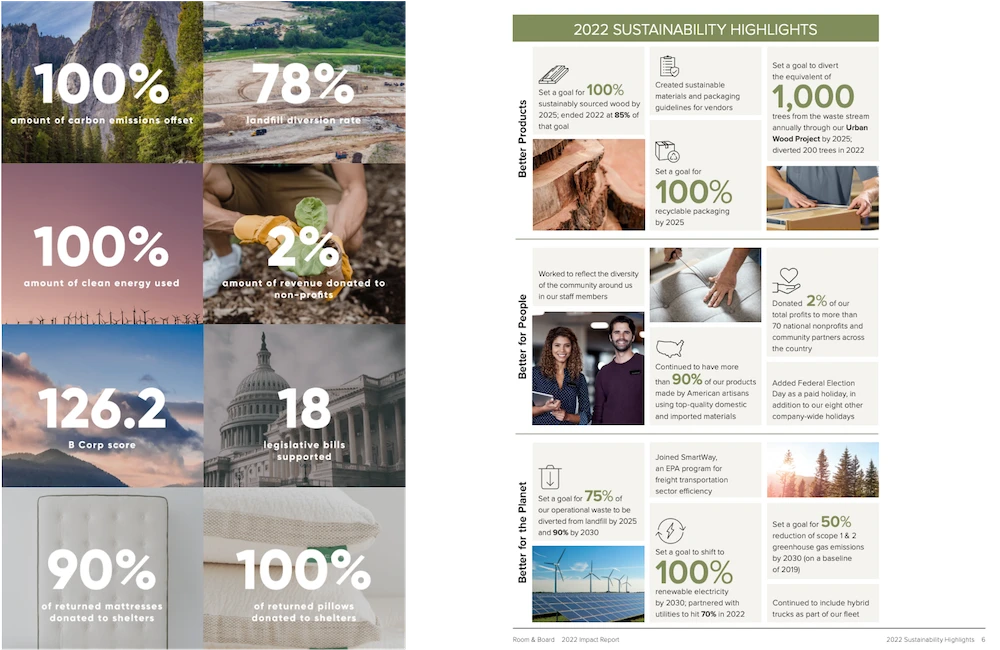
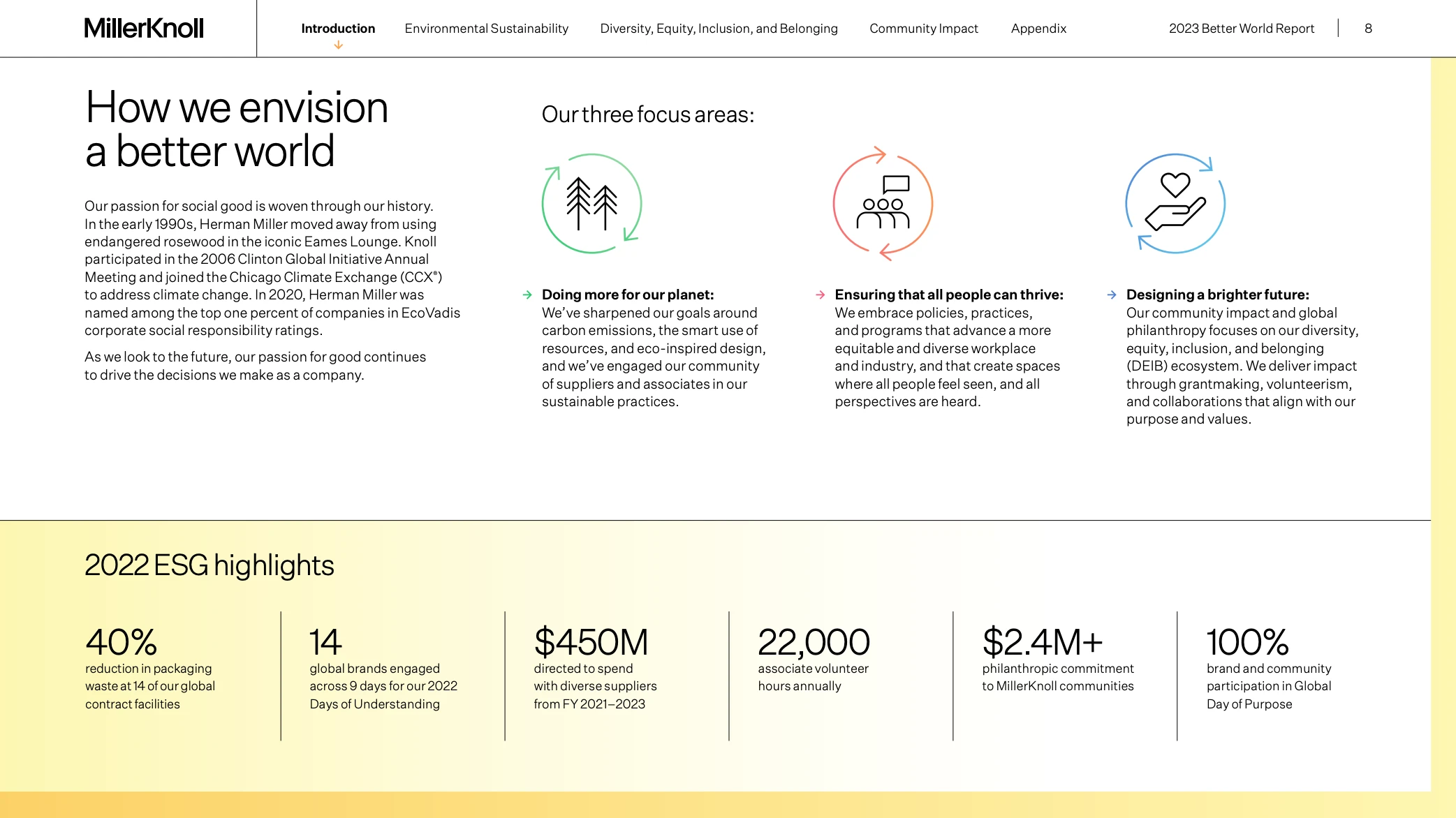
IMPACTS

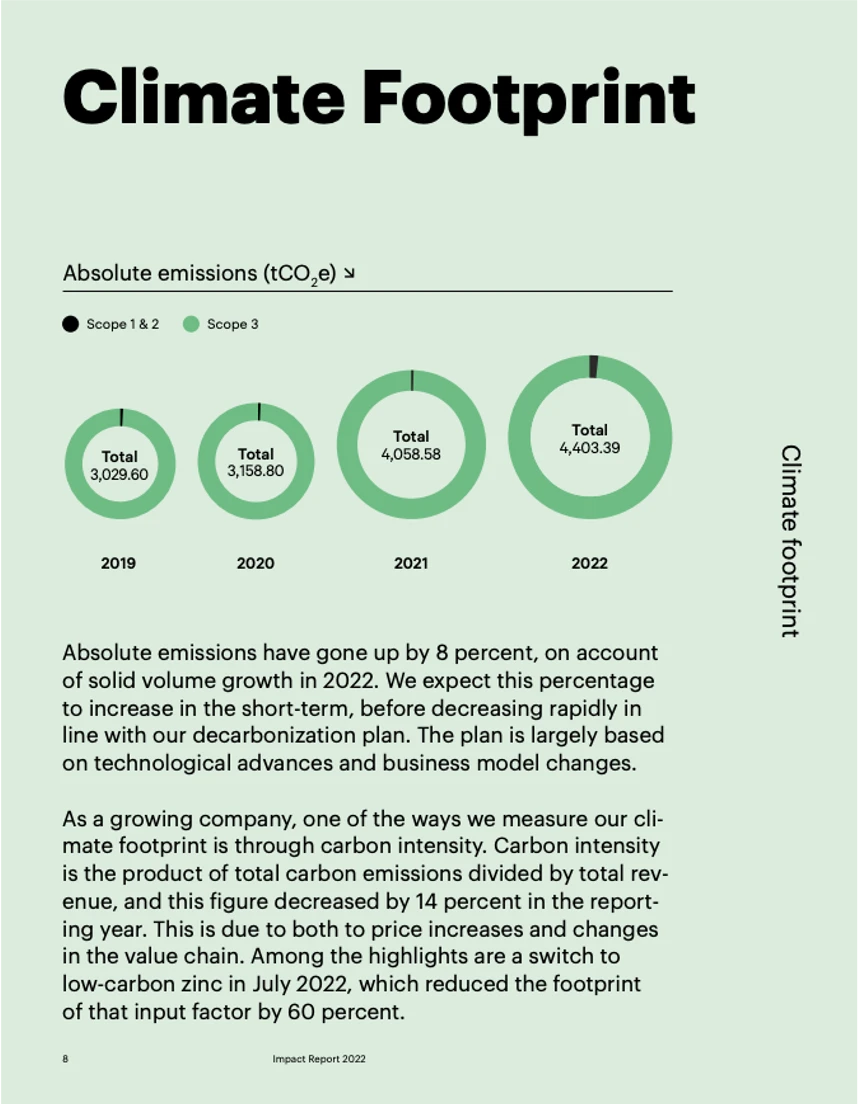
METRICS AND KEY PERFORMANCE INDICATORS (KPIs)





GOALS AND TARGETS


ROADMAP
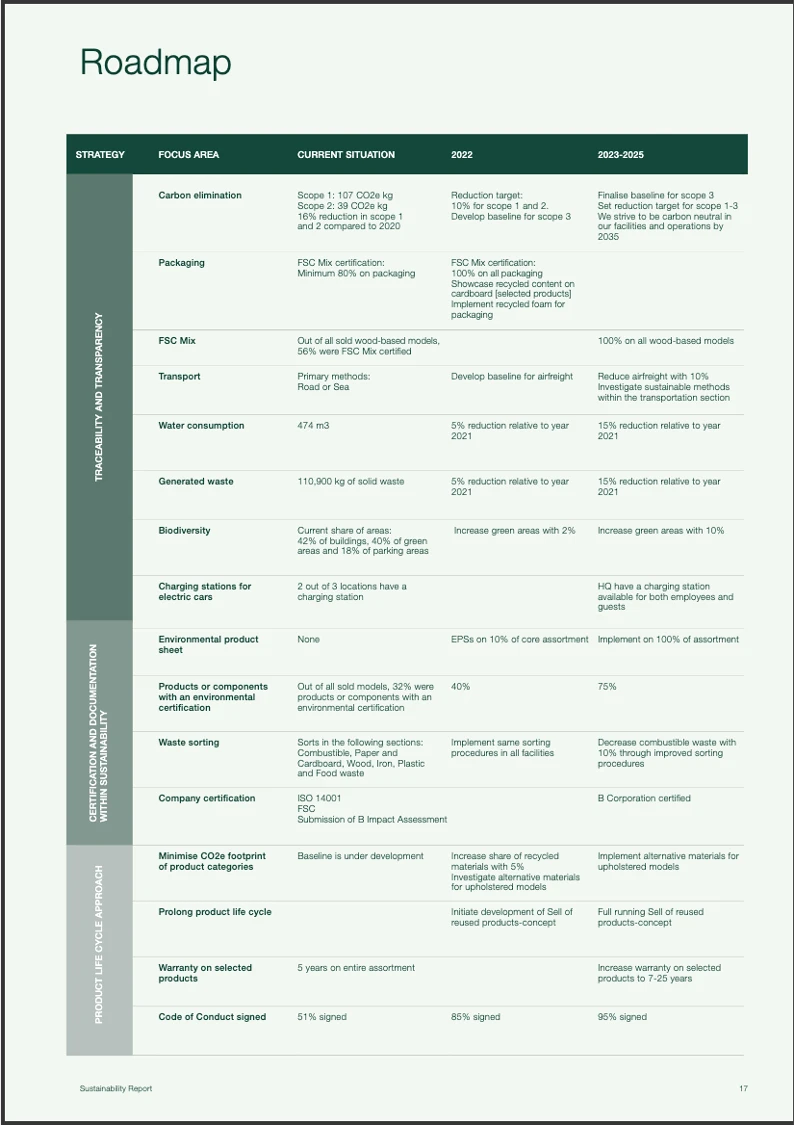


If this is not your first report, seek to track change from year to year:
PROGRESS AGAINST TARGETS

You might also include these two features:
A statement by the Founder, Owner, Managing Director or CEO - Demonstrating a substantial commitment to sustainability helps to ensure support for the company’s sustainability journey internally. A statement from the senior decision-maker is a requirement of the GRI reporting standard. Governance Structure - This is the place to note who is responsible for driving the company’s sustainability agenda and highlight the leadership behind it. Detailing governance structure is also required by the GRI. Teknion’s Impact Report 2022 shows the full team responsible for driving the sustainability roadmap - alongside a message from the CEO noting that “the past two years have taught us that we can’t just rely on a comfortable evolution toward greater sustainability.” First, proofreading! Recruit a colleague with a keen eye for detail to make sure everything in your draft impact report makes sense and double-check for errors. Then send the draft to your company’s highest level of sustainability accountability, usually the Managing Director or CEO. This is an opportunity to provide explanations or information needed to ensure buy-in to, and sign-off on, the company’s targets and commitments. Sustainability reports should be publicly available and easily accessible, ideally downloadable as a PDF. After all your hard work, make sure as many as possible read your report! Promote it across all company social media channels and through both outward - and inward-facing communication. Once finished, don’t let your impact report gather dust! This report can serve as your go-to to help motivate – your team and yourself – and to tell the world of your sustainability journey. Your impact report can serve your company as a major catalyst for change! Helene Jortveit Lauvland, “The Carbon Footprint of Furniture,” Norwegian University of Science and Technology (NTNU), Master’s thesis in Energy and Environmental Engineering, Supervisor: Johan Berg Pettersen, January 2021
What's next?
WATCH Webinar #1:
READ Action Guide #2: Understanding Your Impacts
WATCH Webinar #2:
READ Action Guide #3: Opportunities for change
SOURCES
Planetary boundaries, Stockholm Resilience Centre, Stockholm University
Mandatory Sustainability Disclosures (UK), Sustain IQ
2023 Global 100 Most Sustainable Corporations, Corporate Knights
Mind the Purpose Gap, Deloitte Insights
